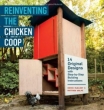Red Mite
Whilst there are several different species of poultry mites that can affect chickens, red mite is by far the most common and difficult to remove. Despite their name, they actually start life as a small grey coloured mite but turn red once they have had a blood feed.
 A typical clump of red mite after a blood feed.
A typical clump of red mite after a blood feed.
Red mite are active when your chickens are roosting, they will crawl on to them for a night time feed which typically takes 1 to 2 hours. They won’t usually be found on your birds during the daytime, but hiding in the cracks and crevaces of your chicken house. They are almost always found near perch ends, but as the number of red mite multiply, they will be found in many other places around the coop until the whole coop will be crawling with them.
The reason red mite are such a problem both commercially and to smallholders / backyard chicken keepers is because of their rapid breeding rate and amazing ability to hide away to survive anti-mite treatments. It is not uncommon to have to repeat treatments several times to bring them under control and then ‘manage their numbers’ over the summer months, without actually removing them completely from the coop.
The Signs and Symptoms
Red mite are only active during mild weather, so in the UK the red mite season usually falls between April and October. During cold weather, the mites become dormant and do not feed.
Chickens will often have a pale comb and stop laying once the infestation becomes significant. Sometimes hens will refuse to go into the coop at night and may try to roost elsewhere. Red mite cause anemia and eventually death so are a parasite that needs dealing with as early as possible.
Red mite can usually be spotted under perch ends and in cracks where birds roost. Mature mites are up to 1mm in size so are visible with the naked eye. They also leave a tell-tale grey ‘ash like’ excretion which is sometimes easier to spot.
 A red mite infestation found behind a detachable nest box.
A red mite infestation found behind a detachable nest box.
When collecting eggs, you may find smears of blood on eggs which are squashed mites. Broody hens are particularly at risk whilst they are sitting so their nest box should be examined carefully and hens should be dusted with a red mite powder periodically. This will also help with lice, another common (but less serious) external parasite.
The best way to check for red mite is to go out to the hen house at night, armed with a white tissue. Wipe the underneath of the perch where your hens are roosting and look for smeared blood on the tissue that will indicate their presence.
The Life Cycle of Red Mite
In order to tackle a red mite infestation, it is important to understand their life cycle first. Red mites reproduce very quickly during the summer months, hatching and turning into egg laying adults in about a week. A female lays thousands of eggs, so within a couple of weeks your chicken coop can be overrun.
It is important to remember to re-treat the coop before eggs that got missed during the first treatment, hatch and mature into egg laying adults. I try to re-treat my coops no more than 5 days apart in summer if I have found red mite.
 A macro photograph showing eggs and the different sizes of red mite.
A macro photograph showing eggs and the different sizes of red mite.
Unfortunately, red mite can survive for up to 8 months without a feed, so leaving a coop empty for a while doesn’t usually fix the problem. The female mite will only lay eggs after a blood feed though, so if you can move your chickens out during treatment, it should help you to get things under control faster, as well as give your birds a rest.
Treating the Coop
Red mite can be controlled using off the shelf products such as poultry shield, diatom, or red mite powder to name a few, although be warned, they are not easy to eradicate once they have taken hold.
I have tried many red mite products over the years and it’s worth mentioning that different types of products work in different ways, so a combination usually works better. For example, liquids like poultryshied will run into the cracks but after the coop is dry, powders such as diatom can be dusted onto perches and in bedding and will have a longer lasting residual effect.
 Washing coop after cleaning with Poultry Shield.
Washing coop after cleaning with Poultry Shield.
If mites have gone under a felt roof, they are almost impossible to remove, so you will normally need to remove the felt completely. Modern corregated roofing such as Onduline can usually be purchased in DIY stores and is usually a better alternative to a felt roof as far as red mite are concerned.
Once you have them, red mite are notoriously difficult to get rid of, so it is a good idea to inspect your coop regularly, treating it at the first sign of them setting up home.
- Previous « Poultry Pests & Diseases
- Next Lice »

About Tim Daniels
Tim is a poultry enthusiast and keeps chickens, ducks, and geese at his home in Bedfordshire. He runs the hobby website poultrykeeper.com in his spare time.
Further Reading
 Chicken & Eggs: River Cottage Handbook No.11 Mark Diacono |  Storey's Guide to Raising Chickens Gail Damerow |  A Beginners Guide to Caring for Ex-Batts Jo Barlow |  Reinventing the Chicken Coop Matthew Wolpe |  Chickens: The Essential Guide to Choosing and Keeping Happy, Healthy Hens Suzie Baldwin |
Smallholding shop
When you click links below and make a purchase, this may result in this site earning a commission from eBay.

Poultry Red mite Control Blitz Kit
… from £12.80 + p&p

Redmite Powder 500g
Barrier Healthcare dusting… from £8.13 + p&p

Diatom 2KG
Diatomaceous earth… from £14.98 + p&p

Poultry Shield 5L
Poultry shield is a… from £17.55 + p&p
















